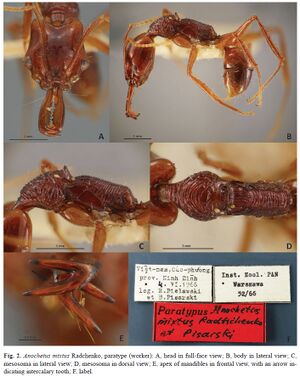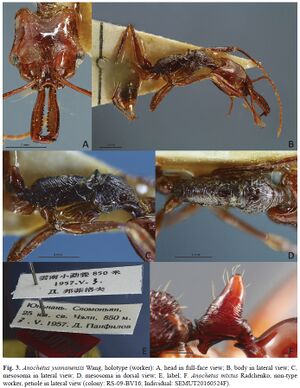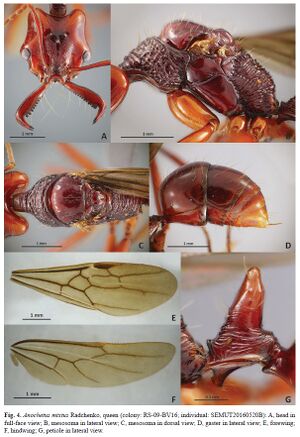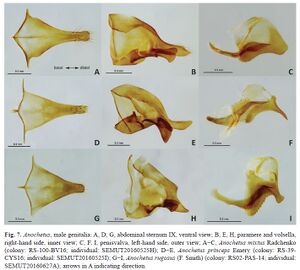Anochetus mixtus
| Anochetus mixtus | |
|---|---|

| |
| Scientific classification | |
| Kingdom: | Animalia |
| Phylum: | Arthropoda |
| Class: | Insecta |
| Order: | Hymenoptera |
| Family: | Formicidae |
| Subfamily: | Ponerinae |
| Tribe: | Ponerini |
| Genus: | Anochetus |
| Species group: | rugosus |
| Species: | A. mixtus |
| Binomial name | |
| Anochetus mixtus Radchenko, 1993 | |
| Synonyms | |
| |
Anochetus mixtus inhabits secondary and primary forests in lowlands to highlands, and nests in rotting wood or beneath the bark of rotting wood (Satria et al., 2017).
Identification
A member of the rugosa group. Brown (1978) defined the group: Large to medium-sized forms with single, serially dentate inner margins; mesonotal disc with a raised anterior rim; petiole bluntly pointed or narrowly rounded at apex. Male (of princeps) without pygidial spine.
Satria et al. (2017) - The other three species in the group differ by the following worker characters: Anochetus muzziolii - Pronotal disc smooth and shiny; mandible short (MdI < 60). Anochetus princeps - Pronotal disc smooth and shiny; mesosoma relatively slender; petiole in lateral view with a relatively long anterior peduncle. Anochetus rugosus - Head in full-face view largely striated; lateral face of head partly striated; ventral face of head smooth and shiny; mesosoma relatively short and stout; petiolar node in lateral view with anterior face sinuate and posterior face weakly convex; anterior third of mesopleuron finely sculptured; propodeum coarsely rugose; petiolar node largely coarsely rugose.
Species discrimination based on male genitalia and associated sclerites (no males known for A. muzziolii). Anochetus mixtus is easily distinguished from the other species in the Anochetus rugosus group by the following characters: abdominal sternum IX much longer than broad with obtuse posterolateral corners (in A. princeps much longer than broad, without posterolateral corners; in A. rugosus slightly longer than broad, without posterolateral corners); dorsal outline of paramere weakly convex (in A. rugosus straight, gradually sloping downward to angulate distidorsal part); distiventral part of valviceps produced but shorter than broad, truncate distally (in A. princeps forming an acute, pointed and slightly downcurved projection which is much longer than broad; in A. rugosus forming a subrectangular lobe which is longer than broad); valviceps with 23−24 denticles on the ventral margin (in A. princeps with 13−14 denticles on the ventral margin, and with ca. 10 denticles on the dorsodistal margin; in A. rugosus strongly concave with 19 denticles on the ventral margin, and 9 denticles on the distal margin of the lobe). See figures in male caste section below.
Chen et al. (2019) - China: Anochetus mixtus is similar to Anochetus rugosus, but can be distinguished from the latter by the following characters: vertex smooth and shining; upper half of petiolar node smooth and shining, basal half weakly striate.
Keys including this Species
- Key to Chinese species of Anochetus
- Key to the Anochetus Species of Asia, Melanesia and the Pacific Region
Distribution
Latitudinal Distribution Pattern
Latitudinal Range: 21.91863889° to 18.74°.
| North Temperate |
North Subtropical |
Tropical | South Subtropical |
South Temperate |
- Source: AntMaps
Distribution based on Regional Taxon Lists
Oriental Region: Vietnam (type locality).
Palaearctic Region: China (type locality).
Distribution based on AntMaps
Distribution based on AntWeb specimens
Check data from AntWeb
Countries Occupied
| Number of countries occupied by this species based on AntWiki Regional Taxon Lists. In general, fewer countries occupied indicates a narrower range, while more countries indicates a more widespread species. |

|
Estimated Abundance
| Relative abundance based on number of AntMaps records per species (this species within the purple bar). Fewer records (to the left) indicates a less abundant/encountered species while more records (to the right) indicates more abundant/encountered species. |

|
Biology
Castes
Worker
 
| |
| . | |
Queen

| |
| . | |
Male
  
| |
| . | |
Nomenclature
The following information is derived from Barry Bolton's Online Catalogue of the Ants of the World.
- mixtus. Anochetus mixtus Radchenko, 1993a: 77, figs. 3-5 (w.) VIETNAM, CHINA (Yunnan).
- Type-material: holotype worker, 5 paratype workers.
- Type-locality: holotype Vietnam: Ninh Binh Distr., Cuc-phu’óng, 4.vi.1966, primary tropical forest (R. Bielawski & B. Pisarski); paratypes: 2 workers with same data, 1 worker Vietnam: Cuc-phu’óng, 3.i.1971 (A. Zakharov), 1 worker Vietnam: 50 km. N Thaj-Ngujen, 300 m., 13.ix.1962, forest (Kabakov), 1 worker China: Yunnan, Jugnnagn, Dadugan, 800 m., 3.v.1957 (D. Panfilov).
- Type-depositoies: MIZW (holotype); MIZW, ZMUM (paratypes).
- Satria, Bui & Eguchi, 2017: 6 (q.m.)
- Status as species: Bolton, 1995b: 65; Guénard & Dunn, 2012: 58; Satria, Bui & Eguchi, 2017: 6 (redescription); Chen, Z., Yang & Zhou, 2019: 62 (redescription).
- Senior synonym of yunnanensis: Satria, Bui & Eguchi, 2017: 4; Chen, Z., Yang & Zhou, 2019: 62.
- Distribution: China, Vietnam.
- yunnanensis. Anochetus yunnanensis Wang, M. 1993a: 226, fig. 7 (w.) CHINA (Yunnan).
- Type-material: holotype worker, 1 paratype worker.
- Type-locality: holotype China: Yunnan Prov., Xiaomengyuang, 850 m., 3.v.1957 (Panfilov).
- Type-depository: IZAS.
- Status as species: Bolton, 1995b: 66; Zhou & Ran, 2010: 103; Guénard & Dunn, 2012: 58.
- Junior synonym of mixtus: Satria, Bui & Eguchi, 2017: 4; Chen, Z., Yang & Zhou, 2019: 62.
Unless otherwise noted the text for the remainder of this section is reported from the publication that includes the original description.
Description
Worker
Satria et al. (2017) - Paratypes of Anochetus mixtus (n=2; PTH and PTL were unable to be measured because the measuring points were hidden by the other parts of body, and thus PTHI was not given): HL 1.96 mm, HW 1.73−1.74 mm, MDL 1.26−1.27 mm, EL 0.29 mm, SL 1.81−1.82 mm, WL 2.51−2.60 mm, CI 88.26−88.77, MDI 64.28−64.79, SI 92.35−92.86.
Holotype of Anochetus yunnanensis: HL 2.01 mm, HW 1.84 mm, MDL 1.31 mm, EL 0.26 mm, SL 1.83 mm, WL 2.68 mm, PTH 0.82 mm, PTL 0.53 mm, CI 91.54, MDI 65.17, SI 91.04, PTHI 154.71.
Non-types (n=10): HL 1.95−2.06 mm, HW 1.78−1.89 mm, MDL 1.30−1.39 mm, EL 0.29−0.31 mm, SL 1.81−1.90 mm, WL 2.58−2.68 mm, PTH 0.80−0.85 mm, PTL 0.52−0.56 mm, CI 89.50−93.53, MDI 66.00−68.66, SI 91.58−94.52, PTHI 148.14−154.72.
Body relatively large (HL 1.95−2.06 mm, WL 2.58−2.68 mm). Head in full-face view slightly longer than broad (CI 88.26−88.77); ocular prominence strongly produced; posterior margin of head strongly concave. Compound eye large and oval. Mandible long (MDL 1.30−1.39 mm), slightly broadened from the base toward the midlength; masticatory margin with 11–14 distinct denticles which are arranged in a single row and gradually increase in size towards apex; intercalary tooth located at the midlength of apical tooth, well developed. Palp formula 4, 4. Antenna 12-segmented; scape long, surpassing posterior margin of head when its laid backward, with weakly curved at distal third. Mesosoma in lateral view relatively slender. Pronotum in lateral view forming a gentle and weakly convex slope from the posterior border to pronotal neck; mesopleural furrow conspicuous, obliquely running; upper part of mesopleuron (above the mesopleural furrow) distinctly carinate anteriorly and dorsally, forming a roundly produced anterodorsal lobe; mesonotum with an anterior transverse ridge which is usually concave medially in frontal view. Dorsal face of propodeum in lateral view long, almost straight, very gently sloping posteriad. Posterior margin of propodeum in lateral view short, gently sloping; the two faces meeting at an obtuse angle. Petiolar node in frontal and lateral views with a bluntly pointed apex, in lateral view with anterior slope almost straight and posterior slope weakly convex. Subpetiolar process in lateral view developed well as a rectangular lobe which is directed anteroventrally.
Dorsal, lateral and ventral faces of head largely smooth and shiny, but frons distinctly striate obliquely to longitudinally. Frontal lobe weakly striate. Pronotal disc coarsely rugose. Mesonotum with sparse longitudinal rugae. Mesopleuron smooth and shiny. Metapleuron and propodeum with dense transversal rugae. Petiolar node with its basal half weakly striate. First gastral tergum smooth and shiny.
Head, mesosoma, petiole and gaster with sparse, erect to suberect setae which vary in length. Head, mesosoma, petiole and gaster with sparse, decumbent to apressed pubescence which is very short on head and gaster. Body reddish brown; mesosoma little darker than head and gaster; antennal scape reddish brown, with funiculus slightly paler; all legs brown with tibiae and tarsi slightly darker than coxae and femora.
Queen
Satria et al. (2017) - Non-types (n=10): HL 2.08−2.15 mm, HW 1.97−2.04 mm, EL 0.39−0.40 mm, MDL 1.38−1.43 mm, OL 0.07−0.09 mm, SL 1.93−1.99 mm, WL 2.95−2.98 mm, PTH 1.00−1.04 mm, PTL 0.59−0.62 mm, CI 93.81−97.61, MDI 65.71−68.42, SI 89.77−94.76, PTHI 163.93−176.27.
Body structure similar to that of the worker except in the following features: median and lateral ocelli present; distance between lateral ocelli longer than distance between lateral and median ocelli. Mesosoma with main sclerites associated with wing function, in dorsal and lateral views relatively short and stout; pronotum in lateral view forming a gentle and almost straight slope from the posterior border to the pronotal neck; anterodorsal outline of mesoscutum in lateral view strongly and roundly raised; mesoscutum in dorsal view, with a weak posteromedian furrow, without notaular lines, with parapsidal lines of which each is recognized as a weak impression; dorsal face of propodeum in lateral view relatively short, almost straight, relatively steeply sloping posteriad; posterior face of propodeum in lateral view short, steeply sloping. Wing venation as in images. Petiolar node in lateral view short and high; anterior and posterior faces meeting at an obtuse angle.
Sculpture of head similar to that of the worker: pronotum coarsely rugose; mesoscutum, mesoscutellum, and mesopleuron smooth and shiny; propodeum with dense transversal rugae; petiolar node largely striate with its apical half or one third smooth and shiny.
Pilosity similar to that of the worker. Color pattern similar to that of the worker.
Male
Satria et al. (2017) - Non-types (n=10): HL 1.03−1.06 mm, HW 1.29−1.33 mm, EL 0.61−0.64 mm, OL 0.14−0.15 mm, OED 0.26−0.28 mm, SL 0.21−0.23 mm, WL 2.50−2.58 mm, FWL 5.01−5.04mm, PTH 0.77−0.79 mm, PTL 0.49−0.51 mm, CI 121.70−128.15, SI 19.81−21.70, PTHI 154.90−157.14.
Body large (HL 1.03−1.06 mm, WL 2.50−2.58 mm). Antenna 13-segmented; scape short, 1/2 as long as segment III; segment II 1/2 as long as scape; segment III to XIII each extremely long. Palp formula 5, 4. Dorsal outline of clypeus in lateral view strongly convex. Anterior clypeal margin almost straight medially. Labrum rectangular, with distal margin triangularly emarginate. Mandible reduced to a triangular lobe. Mesosoma in dorsal and lateral views short and stout; pronotum forming a vertical and weakly convex slope from the posterior border to the pronotal neck; anterodorsal outline of mesoscutum strongly and roundly raised. Mesoscutum Mesoscutum in dorsal view with strong notauli of which posterior part forms a single longitudinal furrow (thus Y-shaped as a whole), and with very weak and slightly curved parapsidal lines. Mesopleural furrow relatively deep and wide, obliquely running. Dorsal margin of propodeum in lateral view relatively short, almost straight, steeply sloping posteriad; its posterior margin short, almost verti-cal; the two margins meeting at an obtuse angle; metapleuron distinctly separated from propo-deum by a suture. Petiolar node in lateral view tapering to blunt apex, with anterior slope almost straight and posterior slope sinuate. Subpetiolar process in lateral view rectangular. Abdominal tergum VIII without a median spine.
Abdominal sternum IX (subgenital plate) longer than broad, triangular, tapering toward subrectangular apex, with obtuse but distinct posterolateral corners. Dorsal outline of paramere weakly convex. Distiventral part of valviceps produced but shorter than broad, truncate distally. Ventral margin of valviceps very weakly concave, with 23−24 denticles; its distal and dorsal margins straight, without denticles.
Wing venation similar to queen.
Head (excluding the venter), mesosoma (excluding mesoscutum, mesoscutellum and propodeum) and gaster largely smooth and shiny, but covered with dense hair pits. Venter of head faintly striate and shiny. Mesoscutum and mesoscutellum faintly striate; scuto-scutellar suture with sparse, strong, longitudinal rugae. Propodeum with faint texture, with weak rugae on its posterior slope. Petiole largely smooth and shiny, with basal area faintly striate.
Head, mesosoma, and gaster with fine dense subdecumbent to decumbent pubescence. Mandible, vertex near ocelli, petiole and gaster with several long setae.
Body, all legs, and antenna yellow, with posterior two third of head little darker than the remainder of body.
Type Material
Satria et al. (2017) - paratype (2 workers in Museum of the Zoological Institute of the Polish Academy of Sciences), Vietnam: Ninh Binh: Cuc Phuong, 4.vi.1966, R. Bielawski and B. Pisarski leg.
References
- Chen, Z., Yang, Z., Zhou, S. 2019. Review of the ant genus Anochetus Mayr, 1861 (Hymenoptera, Formicidae) from China, with revival of the valid status of Anochetus gracilis. Journal of Hymenoptera Research 68: 49–74 (DOI 10.3897/jhr.68.30784).
- Liu, C., Fischer, G., Hita Garcia, F., Yamane, S., Liu, Q., Peng, Y.Q., Economo, E.P., Guénard, B., Pierce, N.E. 2020. Ants of the Hengduan Mountains: a new altitudinal survey and updated checklist for Yunnan Province highlight an understudied insect biodiversity hotspot. ZooKeys 978, 1–171 (doi:10.3897/zookeys.978.55767).
- Radchenko, A. G. 1993a. Ants from Vietnam in the collection of the Institute of Zoology, PAS, Warsaw. I. Pseudomyrmicinae [sic], Dorylinae, Ponerinae. Ann. Zool. (Warsaw) 44: 75-82 (page 77, figs. 3-5 worker described)
- Satria, R. 2017. Taxonomy of the ant genus Odontomachus (Hymenoptera: Formicidae: Ponerinae) in the Indo-Chinese and Indo-Malayan subregions. Ph.D. thesis, Tokyo Metropolitan University.
- Satria, R., Viet, B.T., Eguchi, K. 2017. New synonymy and redescription of Anochetus mixtus Radchenko, 1993, and distinction from the other members of the Anochetus rugosus group (Hymenoptera: Formicidae: Ponerinae). Asian Myrmecology 9: e009006 (DOI 10.20362/am.009006).
References based on Global Ant Biodiversity Informatics
- Chen Z., Z. Yang, and S. Zhou. 2019. Review of the ant genus Anochetus Mayr, 1861 (Hymenoptera, Formicidae) from China, with revival of the valid status of Anochetus gracilis. Journal of Hymenoptera Research 68: 49–74.
- Guénard B., and R. R. Dunn. 2012. A checklist of the ants of China. Zootaxa 3558: 1-77.
- Lu Z., and Y. Chen. 2016. Effects of habitat on ant functional groups: a case study of Luchun County, Yunnan Province, China. Chinese Journal of Eco-Agriculture 24(5): 801-810.
- Ogata K. 2005. Asian ant inventory and international networks. Report on Insect inventory Project in Tropic Asia TAIIV: 145-170.
- Radchenko A. G. 1993. Ants from Vietnam in the collection of the Institute of Zoology, PAS, Warsaw. I. Pseudomyrmicinae, Dorylinae, Ponerinae. Annales Zoologici (Warsaw) 44: 75-82.
- Satria R, B. T. Viet, and K. Eguchi. 2017. New synonymy and redescription of Anochetus mixtus Radchenko, 1993, and distinction from the other members of the Anochetus rugosus group (Hymenoptera: Formicidae: Ponerinae). Asian Myrmecology 9: e009006
- Zhang N. N., Y. Q. Chen, Z. X. Lu, W. Zhang, and K. L. Li. 2013. Species diversity, community structure difference and indicator species of leaf-litter ants in rubber plantations and secondary natural forests in Yunnan, southwestern China. Acta Entomologica Sinica 56(11): 1314-1323.


